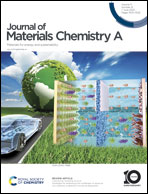Redox-active polynaphthalimides as versatile electrode materials for high-voltage, high-rate and long-cycle-life organic Li-ion batteries†
Abstract
Multifunctional energy-storage devices show great promise in reducing the size and volume of devices, improving the storage capacity, and minimizing the cost of materials and fabrication while eliciting the benefits of additional functions to the system. Herein, we report three new triphenylamine-based polynaphthalimides (TPA-PNIs) that can work as a cathode, anode, and binder in lithium-ion batteries simultaneously. A TPA-PNI cathode delivered a high specific capacity up to 195 mA h g−1 after 100 cycles at 50 mA g−1. A maximum capacity of 1092 mA h g−1 could be stored in the TPA-PNI anode after 100 cycles at 100 mA g−1. A binder-free TPA-PNI cathode showed stable cycling performance with a maximum capacity of ∼202 mA h g−1 after 100 cycles at 50 mA g−1. TPA-PNI electrodes also demonstrated good cycling stability over 5000 cycles under a high current density of 2000 mA g−1, as well as excellent rate capability at a current density up to 5000 mA g−1. The electrochemical performance of TPA-PNI was among the best compared with that of other reported polymer-based electrodes. Detailed mechanistic studies and structural design of these ambipolar TPA-PNI electrodes could: (i) offer insights into the material selection and performance optimization of multifunctional energy storage devices at this early stage of research and development; and (ii) open new opportunities for the development of various high-performance multifunctional energy-storage systems for a wide range of applications.



 Please wait while we load your content...
Please wait while we load your content...